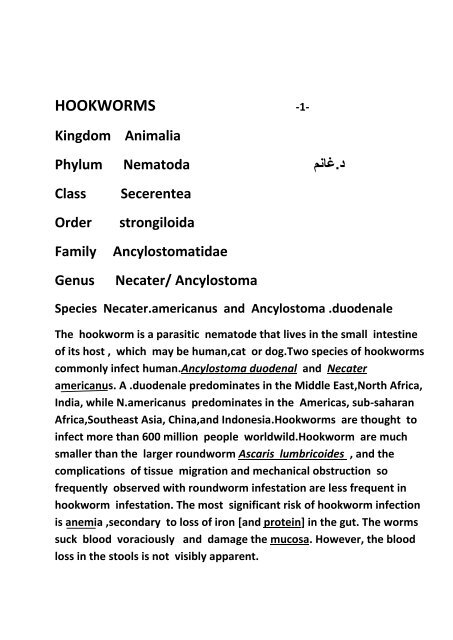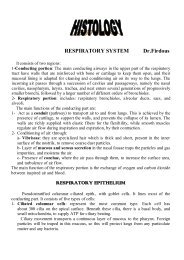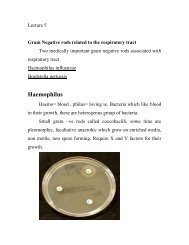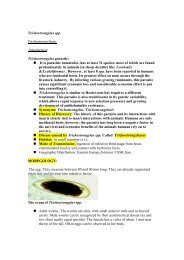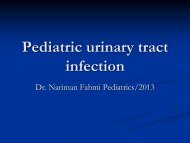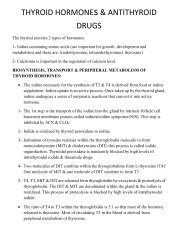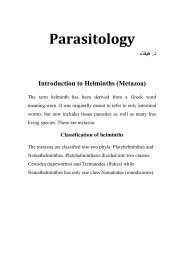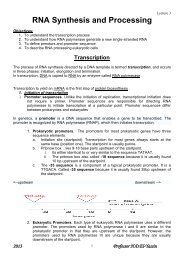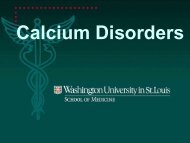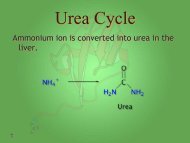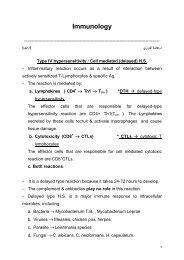HOOKWORMS
HOOKWORMS
HOOKWORMS
You also want an ePaper? Increase the reach of your titles
YUMPU automatically turns print PDFs into web optimized ePapers that Google loves.
<strong>HOOKWORMS</strong> -1-KingdomAnimaliaد . غانم Phylum NematodaClassOrderFamilyGenusSecerenteastrongiloidaAncylostomatidaeNecater/ AncylostomaSpecies Necater.americanus and Ancylostoma .duodenaleThe hookworm is a parasitic nematode that lives in the small intestineof its host , which may be human,cat or dog.Two species of hookwormscommonly infect human.Ancylostoma duodenal and Necateramericanus. A .duodenale predominates in the Middle East,North Africa,India, while N.americanus predominates in the Americas, sub-saharanAfrica,Southeast Asia, China,and Indonesia.Hookworms are thought toinfect more than 600 million people worldwild.Hookworm are muchsmaller than the larger roundworm Ascaris lumbricoides , and thecomplications of tissue migration and mechanical obstruction sofrequently observed with roundworm infestation are less frequent inhookworm infestation. The most significant risk of hookworm infectionis anemia ,secondary to loss of iron [and protein] in the gut. The wormssuck blood voraciously and damage the mucosa. However, the bloodloss in the stools is not visibly apparent.
Ancylostomiasis, ,also known by several other names, is the diseasecaused when A.duodenal hookworms present in large numbers,produce an iron deficiency anemia by sucking blood from the host'sintestinal wall .Hookworm is a leading cause of maternal and childmorbidity in the developing countries of the tropics and subtropics. Insusceptible children hookworms cause intellectual ,cognitive andgrowth retardation,intrauterine growth retardation, prematurity ,andlow birth weight among newborns to infected mothers . In developedcountries , hookworm infection is rarely fatal, but anemia can besignificant in heavily infected individual.MorphologyThe adult parasites are small cylindrical worm. A .duodenale aregrayish white or pinkish with the head slightly bent in relationto the rest of the body. This bend forms a definitive hook shape atthe anterior end for which hookworms are named .They posseswell developed mouths with two pairs of teeth. While malesmeasure ~ one cm X 0.5 millimeter, the females are often longerand stouter .Additionally, males can be distinguished fromfemales based on the presence of a prominent posteriorcopulatory bursa .N.americanus is very similar in morphology toA.duodenal.N. americanus is generally smaller than A.duodenalwith males usually 5 to 6mm long and females about I cm long .Whereas A.duodenal posses two pairs of teeth , N.americanusposses a pair of cutting plates in the buccal capsule. Additionally, the hook shape is much more defined in Necater than inAncylostoma .The eggs are blunting rounded ,thin shelled , and are almost - 2-indistinguishable between the different species , ,measuring 6o x 40
micrometer, the eggs of Ancylostoma being slightly larger than those ofNecater -3-The life cycleThe life cycle of all the hookworms are very similar. The eggs arepassed in feces ,once exposed to air they mature rapidly if conditionsare right ,with both moisture and warmth essential for development. When mature they hatch to liberate a Rabditiform (i.e. having anesophagus where a thick anterior region is connected via a necklineregion with a posterior bulb) L1 larvae after a few days[Thefeeding non –infective rhabditoform stage].These larval nematodes feed on bacteria and organic material in thesoil ,where they live and grow for about 2 days before undergoingthe first molt L2 larvae .After about 5 days more growth they moltagain, to produce a much more slender L3 larvae. The L3 has amuch shorter esophagus , is a non-feeding form , and is infectiveform of parasite [The filariform stage of the parasite. Also calledfilariform larva ]Infection takes place by penetration of" filariform larva" the skin , forexample when walking with bare feet over contaminated dump soil ,followed by entry into the circulatory system. Here they are carried to theheart , and then the lung .Once in the lungs, they are too large to passthrough the capillary bed there .Instead they become trapped, and theyburrow through the capillary epithelium ,entering the air spaces. They thenmigrate up through bronchi and trachea, and are then swallowed .Onceswallowed they pass into the intestine and bury themselves between theintestine villie.Here they molt to form the L4 larvae , equipped with abuccal capsule allowing adherence to the gut wall. After about 13 dayspost-infection they molt for the final time producing immature adult
worms.which become mature after 3-4 weeks(i.e.5-6 weeks after infection), then mat and commence eggs laying to complete the life cycle.These parasites show a very high fecundity ,female Necatorproducing up to 10,000 eggs daily ,whilst female Ancylostomaproduce up to 20,000 eggs daily .Infection of host is by larvae, not the eggs.The usual method ofinfection is through the skin.While the larvae of A.duodenum maypeneterate the buccal mucosa to reach the venous circulation andcomplete their migration via the lung(the filariform larvae beingcarried on contaminated vegetables or fruits) .Also transmammaryand and transplacental transmission has been reported forAncylestome,Pathogenesis and clinical symptoms .Pathogenesis and clinical symptoms depend on the site where theworms present and their burden ( light infection may be notnoticed). The clinical disease in hookworm infection may be due tolarvae or adult worms.Dermal :When filariform larvae enter the skin they cause:*Sever local itching .* An erythematous popular rash may develop (becoming vascular )*Scratching and secondary bacterial infection .This condition ,known as Ground-itch , is more common in infectionwith Necator than with Ancylostoma . -4-
Pulmonary : -5-When filariform larvae break out the pulmonary cappilliers and enterthe alveoli may cause:*Minute local hemorrhages*coughing .*Chest pain .*Wheezing .*And sometimes fever (with large number of larvae).Gastrointestinal :When the adult worms attach themselves to the gut mucosa by theirbuccal capsules they suck into their mouth a portion of intestinalvillie , they utilize gut epithelial cells and plasma for their food , arethe most important manifestations of Ancylostomiasis (or hookwormdisease ) . By the pumping action of the esophagus the worm sucks inblood , which pass out undigested and unutilized through itsintestine . The adult Ancylostoma can suck about 0.2 ml blood a day,while the smaller Necator suck about 0.03 ml a day . The secretions of the worm contain anticoagulant activity ,bleeding from the site may continue for sometimes ,this add toblood loss .Major morbidity associated with hookworm is caused by:*Intestinal blood loss .*Iron deficiency anemia .
*And protein malnutrition . -6-All these result mainly from adult hookworms in the intestineingesting blood, rupturing R.B.Cs ,and degrading hemoglobin in thehost .This long- term blood loss can manifest itself self physicallythrough :*Facial and peripheral edema .*Eosinophilia .*Pica caused by iron deficiency anemia .*Children who suffer from chronic hookworm infection can sufferfrom growth retardation as well as intellectual and cognitiveimpairmentsEarly stage symptoms of gastrointestinal infection are :. Epigastric pain .. Indigestion .. Nausea ..Vomiting .. Constipation ..Diarrhea can occur early or in later stage.Signs of advanced sever infection are those of anemia and proteindeficiency including :.Emaciation .. Cardiac failure .
. And abdominal distention with ascites . -7-DiagnosisDepend on finding characteristic worm eggs on microscopicexamination of the stools , although this is not possible in earlyinfection .The eggs are oval or elliptical ,measuring about 60 micrometers by40 micrometers ,colorless, not bile stained and with a thintransparent hyaline shell membrane. When released by the worm inthe intestine ,the eggs contains an unsegmented ovum . During itspassage down the intestine , the ovum develops and thus the eggspassed in feces have segmented ovum , usually with 4 to 8blastomeresNote :If the fecal sample is left for a day or more under tropical conditions,the larvae will have hatched out , so eggs might no longer beevident. In such cases ,it is essential to distinguish hookworms fromstrongyloides larvae .Adult worms are rarely seen , but if found,would allow definitive identification of the species .Diffrentiation between hookworm and strongyloides larvae based onthe length of the buccal cavity ,the space between the oral openingand the esophagus in hookworm rhabditiform larvae have longbuccal cavities whears strongyloides rhabditiform larvae haveshort buccal cavities .PreventionThe infective larvae develop and survive in an environment of dampdirt , particularly sandy and loamy soil .They cannot survive in clay or
muck. The main lines of precaution are those indicated by sanitaryscience :1-Do not defecate in places other than latrines ,toilet ..etc.2-Do not use human excrement or raw sewage or untreated nightsoil as manur/ fertilizer in agriculture .3-Do not walk barefoot in known infected areas .-8-


